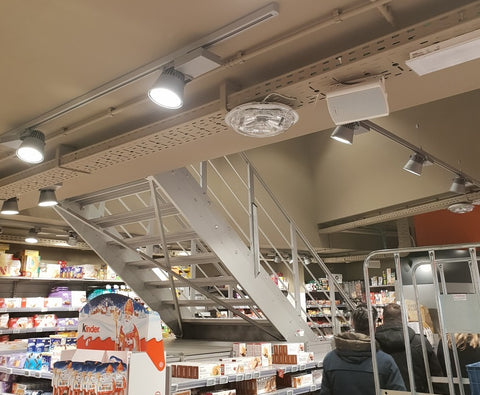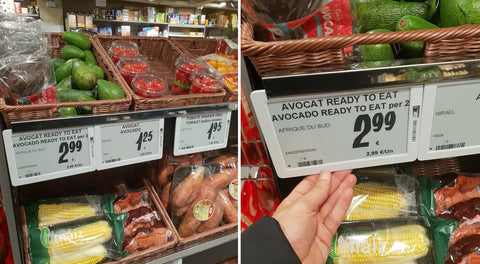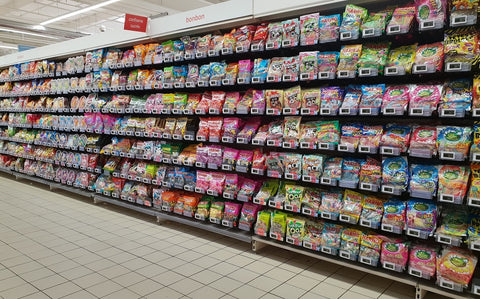
Electronic Price Labels are coming, are you ready?
February 2019
Electronic Store Labels are taking over the world and replacing paper with ePaper. But what are the benefits, costs, issues and what are your options as a retailer?
Background, then and now.
Electronic Shelf Labels started out in the early nineties, multiple companies mainly in Europe started utilizing the then cheap and accessible LCD technology to replace paper, cardboard and permanent labeling. Sitour Electronic Systems (SES) from France and Pricer from Sweden are two of those pioneers. Over a decade of R&D with not so impressive results went into this technology before any proper results were achieved. Up until 2010 or so, these digital pricing systems had many issues such as:
- Low battery life due to high energy consumption screens and chipsets.
- Low visibility in various lighting situations and viewing angles.
- Inability to communicate with the central system without a direct line of sight due the use of infrared technology.
- Bulky labels that were not resistant to humidity, water, sunlight and temperature changes.
- Difficulty connecting and integrating with POS systems.
- Requirement to have stickers on the labels as they couldn't display fine text.
- Heavy, expensive and difficult to maintain servers and core appliances in store.
But hard work paid off and with the introduction of cheaper more reliable tech, WLAN technology became cheaper and more reliable while consuming less energy so the communication was switched to radio frequencies.
ePaper technology got cheaper and better, creating high contrast screens that were easy to read from every angle while consuming very little energy. ePaper became available in low temperature versions as well and red colour was added to e-ink products.
Battery technology boosted, creating cheap high capacity batteries increasing the label lifespan by years.
Cloud systems and advanced API integration and connection software made it easier to plug in the electronic pricing systems to any POS system. Prices were changed instantly, data was backed up and the connection to almost any POS, ERP, IMS or WMS was made easy.
Further advancement in technologies such as blinking LED lights, location tracking of the labels, communication with NFC enabled mobile phones and displaying QR codes also added to the benefits of these systems over traditional paper based technology.
How does it work now?
Well, the first part obviously is the actual labels, stores need to install the labels on the data strips and merchandising systems (that's where Hang & Display comes in). The labels have batteries included and are usually sealed so the end user can not change the battery. Currently the latest products on the market, have battery life spans from 3 to 15 years depending on brand, size, display colors, settings, operating frequency, enabled features and the amount of times the data is updated. That seems like a reasonable amount of time, considering the investment in the labels themselves. I just hope than manufacturers have a plan to recycle these at end of life otherwise they just add to our e-waste problem! The actual labels should cost about $15-$50 and up a piece for small orders of the smaller sizes (under 5 inches in diameter) going down for bulk and enterprise applications. Most suppliers don't have hard MOQ's so you could just buy a carton of 100 or a pallet of 10,000.
The second part is the back-end hardware and software. So depending on store size, a number of RF stations are installed on the ceiling, the stations are about the size of a regular modem. These are connected to a network switch and server somewhere safe in the office or server room of the store. This System has to be connected to the POS system somehow and it seems cloud systems and software integration is how it's done now. This means that all pricing and information changes in the POS are communicated to the ESL server and it can be communicated to the labels instantly. Various brand offer various solutions for the connection and ESL management. Some may provide an interface in which the screen of the ESL can be customized by the retailer, this seems like the best solution as each retailer has different information it wants to present. Plus retailers may wish to change the layout to improve the customer experience. A WiFi connected PDA system can also be integrated for staff to use. The PDA can operate via NFC or just through WiFi and WLAN and implement changes to the labels.
There are rumors that SES-imagotag is working on integrating their communication protocol with WiFi and if that happens it would be ground-breaking as almost every retailer now should have WiFi coverage in the store.
At the moment none of the manufacturers work directly in Australia but some have certified re-sellers and agents here including SES-imagotag and Hanshow. These companies should determine the pricing for these services and at the moment it's not a very competitive market so there won't be many plug and play solutions and retailers may be looking at high setup costs due to all the man hours involved in the setup.

Ceiling mounted transmitters are part of the required infrastructure for ESL's, this one is a Pricer IR dome.
So what are we looking at now?
Right now there seems to be 9 major players in this field. SES-imagotag from France is the biggest player in the market and Pricer from Sweden comes in second. Hanshow and Zkong from China, Solum from South Korea, Altierre and NCR from the USA, Teraoka (DIGI) from Japan and DisplayData from the UK are also offering some solutions but are yet to deploy anything major at least in Australia.
The ESL market has been predicted to be worth over 2 Billion USD in 2019 so no wonder that there are new players joining the market every year. Multiple companies in the electronics sector, many Chinese knock offs of popular designs as well as some startups are trying to cash in on this new tech.
So if you are in the market for ESL what should you expect?
- Manufacturers should offer you labels available multiple sizes from 1.5 inch diameter to 12 inch to suit various products, pick and choose depending on your needs.
- Labels are roughly 10-15mm thick and above 90% screen to front surface ratio. You can Also ask for colored frames instead of white to match your stores theme.
- ePaper to display in 2 (Black on White) or 3 (Black on White with Red) colors. Some companies have announced new products with 4 colors for next year.
- Battery life to be around 5 years or more.
- The manufacturer should offer you an end of life collection or replacement/upgrade plan for the labels so you don't need to throw them away.
- One radio signal emitter per 200-300 square meters or so, installed on your ceiling.
- One server per store or a full cloud solution.
- Integration with your current POS for pricing as well as user defined fields such as product name, features and highlights with custom label layout. You should get some training on the interface and ongoing support as well.

The future?
As with any electronic/digital based product, the future solutions will have:
Lighter and thinner labels
Display more than the 2 or 3 colors available on current ePaper
- Integration with POS will be easier possibly as an app or API capability
- Additional features such as communication with customer apps will be added.
Outside of improvements we predict that the applications will go beyond Retail.
- Warehouses will start using them for fast, easy access to stock.
- Offices, educational institutes and businesses will start using them for meeting rooms and classes, integrating them with calendars to display up to date schedules.

Where does Hang and Display fit into the ESL market?
Hang and Display is the market leader is ESL shelf support and display methods in Australia. As part of the ISD group we have 2 decades of experience working with the manufacturers developing ESL shelf supports for retail. Our R&D team is constantly in contact with the manufacturers providing, easy, strong, cheap and reliable support rails and parts so the labels can be held in place on almost any shelf or hook.
Our engineers have worked and tested various designs to try to come up with one solution fits all systems on as many labels as possible. This way we reduce costs and offer flexibility to the retailers in choosing the label provider that suits them. We have 3 main lines of solutions:
Sitour FreeLine:
The Freeline rails are extruded to size and can hold tickets, electronic labels, dividers, pushers and promotional media at the same time. Available in multiple versions to suit various shelves, the Freeline secures on to the shelf edge and then an array of accessories can be added, One of the accessories is the ESL support than snaps on to the label and then snaps in place in one of many angles as required based on shelf location.
Sitour EasyFix:
An advanced multi material extrusion profile made to size for your shelves. The EasyFix has multiple simple features allowing it to adapt to a wide range of shelves. Once secured to your shelf, the labels snaps in place. We also provide an installation tool, for firm and fast installation of the rail and a label remover tool to quickly remove high quantities of labels. The EasyFix can be ordered with a cover for high impact areas and it takes multiple types of labels from SES, Pricer, Hanshow,...
Individual Supports:
Supports for items displayed on hooks
Adhesive back supports for non shelf surfaces such as acrylic boxes, cabinets, walls,...
Call us now to discuss the best solution for your store!

Comments
Leave a comment